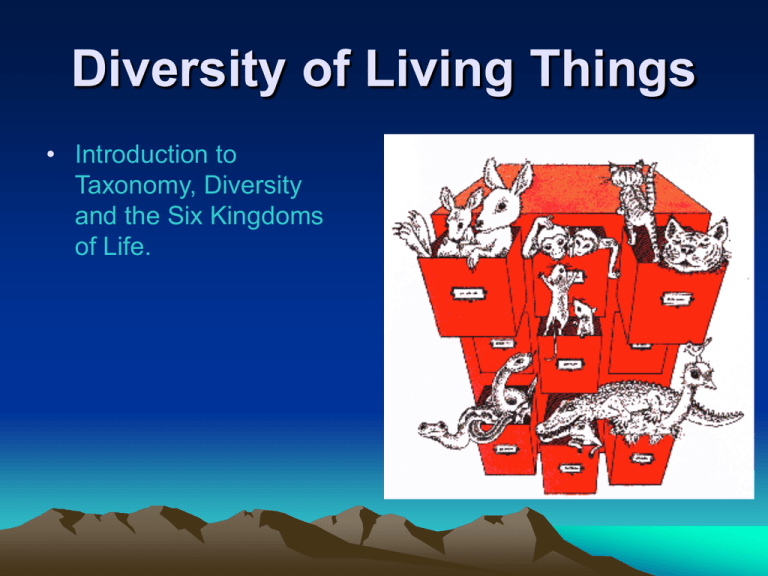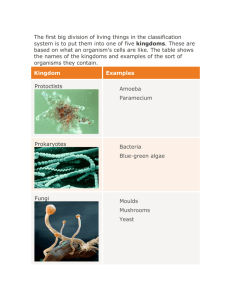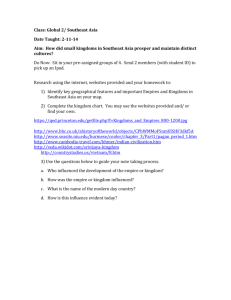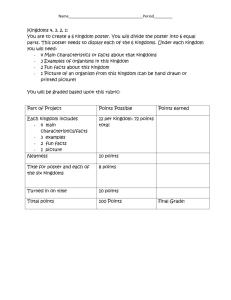Diversity of Living Things
advertisement

Diversity of Living Things • Introduction to Taxonomy, Diversity and the Six Kingdoms of Life. Classification • Everything classifies into one category or another. When you go to the movies you are put into a category for payment. When you use a bank machine you are classified as English speaking or French Speaking… • The categories that are made and the groups that belong in them reflect patterns in the world around us. • A particularly important challenge to biologists, is finding a way to classify Earth’s millions of species. Where to Begin… • Aristotle classified living things into two large groups. He believed everything was either in the Kingdom Animalia or the Kingdom Plantae, terms we still use today. Aristotle’s Animals • Aristotle said that animals were anything that: 1) Moved And 2) Ingested food Aristotle’s Plants • Aristotle said plants were anything that: 1) Stayed put And 2) Obtained food through the Sun (photosynthesis) Exceptions to Aristotle’s ‘Rule’ The move from Aristotle • Aristotle’s thoughts were believed by the majority of the populace right up until the 17th century… when a fantastic invention made the job of classification a whole lot harder… That invention was the microscope Not Confirmed… yet… Classifying becomes harder… • The Microscope made classification a whole lot harder because now a world of previously unseen microscopic organisms could be seen. Some behaved like animals and others like plants, but some did both animal and plant things such as the Euglena (pictured). Leave it to the Germans to make life easier… • In 1866, Ernst Haeckel, a German biologist, proposed classifying all microorganisms that are neither plant nor animal into a third Kingdom, the Kingdom Protista. The Unwritten Rule • ‘If you cannot classify it, make a new Kingdom.’ • Mushrooms and moulds were placed in the animal kingdom because they did not perform photosynthesis… now they are in a 4th Kingdom, the Kingdom Fungi Kingdom #5 • Bacterial cells differ from the cells of the other four kingdoms. • Therefore they were placed into a 5th Kingdom, originally called the Kingdom Monera, but now called Kingdom Bacteria. The 6th and Final Kingdom • In the 1990s there was increased interest in bacteria that grew in extreme environments. Detailed studies showed that these organisms were not in fact bacteria, but differed in protein and RNA structure, thereby splitting the Kingdom Monera into the previously mentioned Kingdom Bacteria and now, the Kingdom Archaea, featuring these extreme environment prokaryotic organisms. Natural Division amongst the Kingdoms • The 6 Kingdoms have a natural division amongst them. The Kingdoms Bacteria and Archaea are both made up of prokaryotes while the other four Kingdoms are made up of eukaryotes. The Organization of the Kingdoms • Detailed studies have shown that Archaea are as different from Bacteria as they are with the eukaryotes, therefore the 6 Kingdoms are put into 3 Domains. • The Domain Archaea has the Kingdom Archaea. • The Domain Bacteria has the Kingdom Bacteria • The Domain Eukarya has the other 4 Kingdoms (Protista, Fungi, Plantae and Animalia) Taxonomy • The purpose of a classification system is to allow the accurate identification of a particular organism, no matter where it exists. • Taxonomy is the practice of classifying organisms The Linnean Classification System • Today’s system of Taxonomy was constructed 300 years ago by Swedish botanist, Carolus Linneaus. • He used physical characteristics to identify different species and separate them into groups. The Linnean classification system • During the colonization of the new world, European explorers were able to identify new species using his system… it was so easy to use. • Today it has been adapted to use DNA, protein and mating behaviours to help in classifying organisms. The Taxonomic Hierarchy • • • • • • • • Domain Kingdom Phylum Class Order Family Genus Species Eukarya Animalia Chordata Mammalia Carnivora Felidae Lynx Rufus Taxonomic Hierarchy • We do not use the whole taxonomic hierarchy when naming. We use the two smallest groups, the Genus and the Species. • This is called binomial nomenclature. • Lynx rufus or Lynx rufus are the acceptable written names for this animal.






